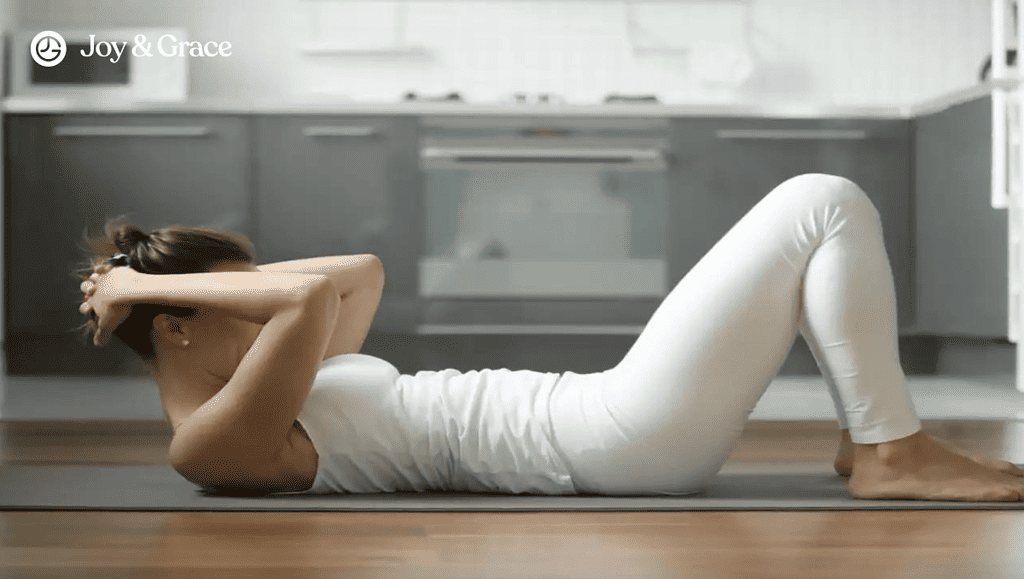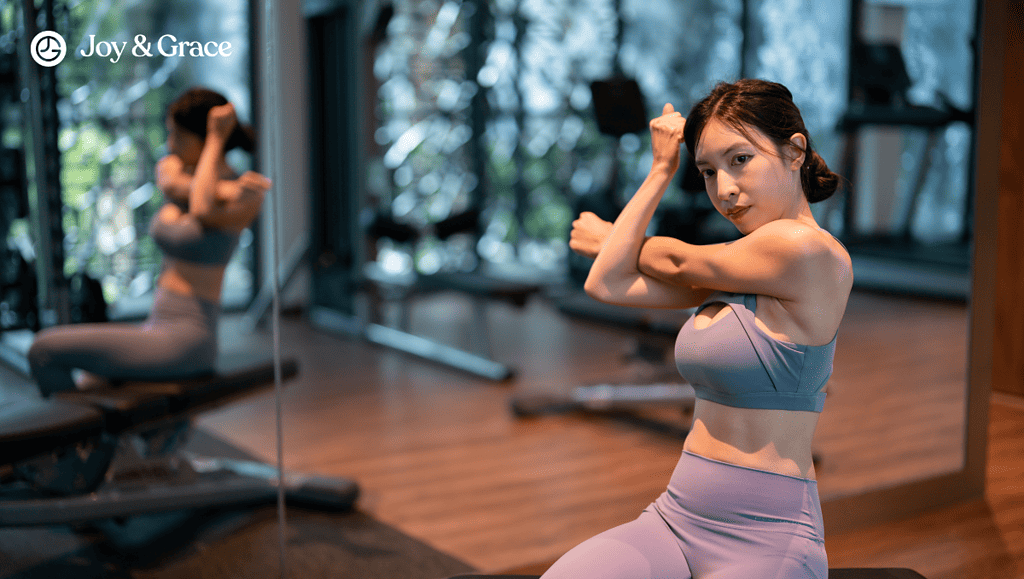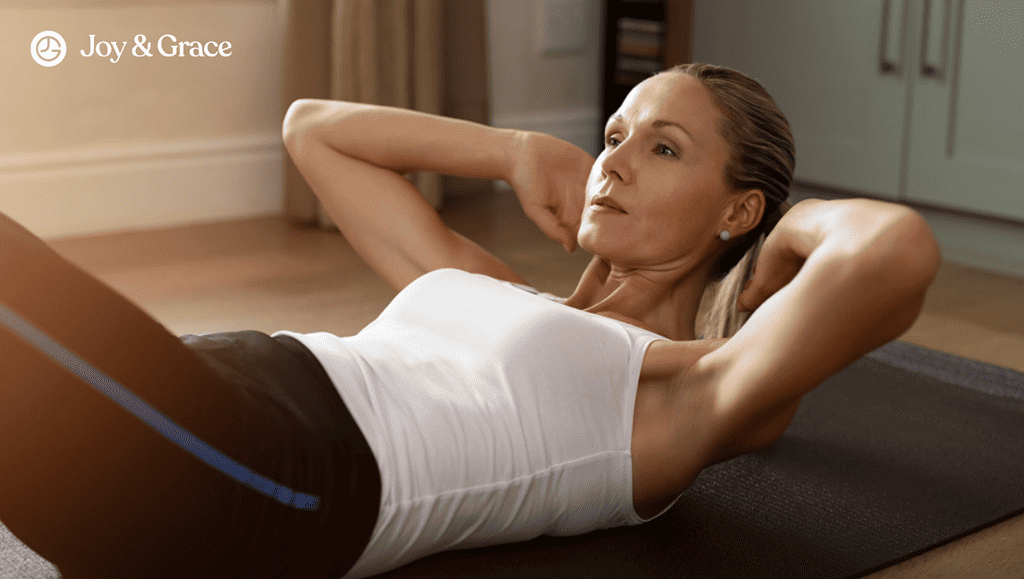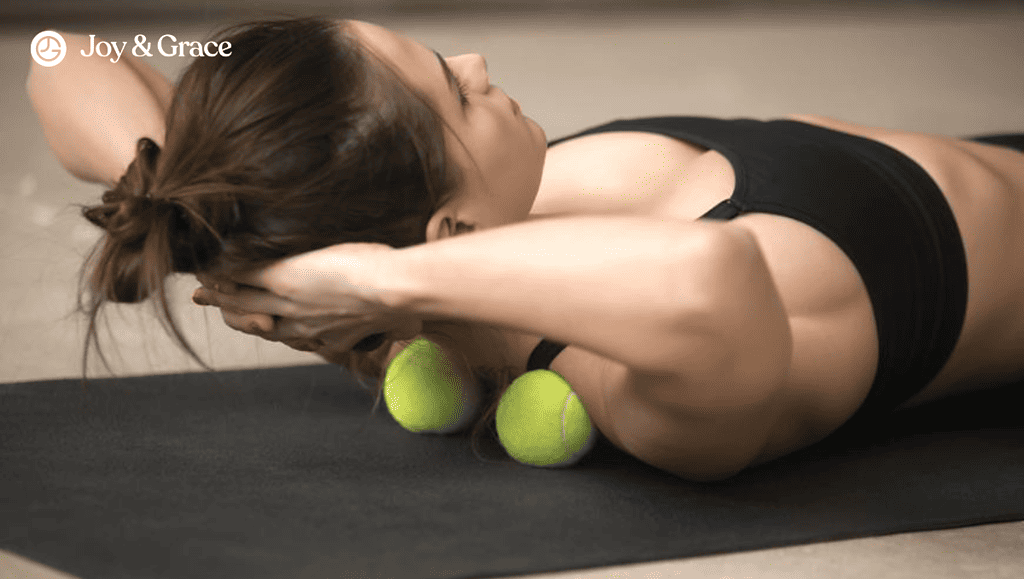Crunches are a popular exercise that are often included in core workout routines. However, many people experience neck pain or discomfort while performing this exercise. If you're one of them, you're not alone. Neck pain during crunches is a common issue, and it can be frustrating and discouraging to deal with.
In this article, we'll dive into why crunches can cause neck pain. We'll also provide practical advice on how to modify your form and posture to perform this exercise safely and effectively. Whether you're a seasoned athlete or a beginner, we hope you'll find this information helpful in achieving your fitness goals.
Why Does My Neck Hurt While Doing Crunches?
The main reason why you experience neck pain when doing neck crunches is that you’re straining your neck muscles. Crunches are a popular exercise known for their effectiveness in toning and strengthening your abs.
However, only a few people realize that you also use your neck muscles when doing crunches. Your neck muscles support your head while your core muscles are engaged during abdominal exercises.
Is Your Neck Supposed To Hurt When Doing Ab Workouts?
The short answer is NO. You might be thinking about “no pain, no gain,” but your neck should not hurt when doing crunches.
As much as we all want a flat stomach and toned abs, we often forget that we should not compromise our health.
The pain might indicate that your neck muscles are under more pressure than they can handle.
Do Crunches Put Pressure on the Neck?

When you perform a crunch, you engage the muscles in your abdominal region, but you may also place significant pressure on the neck muscles. That is especially true if we use improper form while doing the exercise (as we’ll see now).
This pressure can cause discomfort, pain, or even neck injury.
There are a few reasons why crunches can put pressure on the neck. Here are some of them:
- Neck pulling
When performing crunches, it's common to place your hands behind your head to provide support. However, this can result in "neck pulling," which occurs when you use your hands to pull your head forward instead of using your abdominal muscles. This can put unnecessary strain on your neck, leading to pain.
- Poor form
Poor form during crunches can also put pressure on the neck. For example, if you tuck your chin to your chest too much, you can compress the cervical spine and put strain on the neck muscles.
Similarly, if you allow your head to fall back or your shoulders to round forward, you can put additional strain on the neck muscles and joints. It's essential to ensure your form is correct and that your head and neck are aligned with your spine.
- Weak Neck Muscles
If your neck muscles are weak, you may not have the strength to hold your head up during the exercise. This can lead to incorrect alignment and excessive pressure on the neck.
Are Crunches Bad for Your Neck?

Well, it depends on two things:
- Your form, and
- Your overall health
As we’ve been repeating earlier, crunches can put unnecessary strain on the neck muscles when done incorrectly. This can potentially increase the risk of injury. For example, one common mistake we mentioned was pulling on the neck with the hands.
Another factor to consider is whether you already have neck problems, to begin with. It is generally not recommended to do crunches if you have pre-existing neck problems, as it can potentially worsen your condition.
There are several neck conditions in which crunches should be avoided, such as:
- Cervical herniated discs
- Cervical stenosis
- Cervical osteoarthritis
- Whiplash
It is best to consult a healthcare professional (like a physical therapist) before attempting any exercise if you have a history of neck problems or current neck pain. They can assess your condition and provide recommendations to avoid worsening your neck issues.
How Do I Stop My Neck From Hurting When I Do Crunches?

Preparing your body to avoid injury and improve your overall workout experience is important. Here are some steps you can take before doing crunches:
- Warm-up
A proper warm-up is essential before engaging in any physical activity, including crunches. A good warm-up increases blood flow to the muscles and helps prepare them for the demands of the exercise. Warming up before crunches can help prevent injury and reduce the risk of neck pain.
Perform a 5-10 minute cardio warm-up to increase blood flow and prepare your muscles for activity. This could include jogging in place, jumping jacks, or using a stationary bike.
- Stretching
Stretching is another important component of injury prevention. By stretching your neck and shoulder muscles before and after your workout, you can help reduce the risk of a sore and stiff neck.
Gentle stretches, such as neck rolls or shoulder shrugs, can help prevent neck pain during crunches. It's important to remember to stretch slowly and gently and never push your body beyond its limits.
- Alignment
Proper alignment is key to preventing neck pain during crunches. When performing crunches, it's important to maintain good posture and keep your neck in a neutral position.
This means avoiding excessive forward or backward tilting of the head, which can strain the neck muscles. Proper alignment also involves engaging your core muscles fully. You should also avoid jerky or sudden movements that could strain the neck more.
How Do I Perform A Crunch Correctly?
Here are some tips to help you perform a crunch correctly:
1. Start with proper positioning
Lie flat on your back with your knees bent and your feet flat on the ground. Your hands can be crossed on your chest or behind your head, but if you choose the latter, be sure not to pull on your head or neck.
2. Engage your core muscles
Before you begin the movement, take a deep breath and exhale as you contract your abs to lift your shoulders off the ground. Keep your gaze fixed on the ceiling to avoid straining your neck.
3. Lift your shoulders, not your head
The goal of a crunch is to work your abdominal muscles, not to strain your neck. Be sure to lift your shoulders off the ground by contracting your abdominal muscles. Avoid pulling on your neck or using your hands to lift your head.
According to a study, restricting the movement of the neck during crunches can help prevent excessive activation of the muscles in the neck. It may also help focus the activity on the abdominal muscles.
4. Lower down slowly
Once you've lifted your shoulders off the ground, hold the position for a few seconds before slowly lowering to the starting position. Be sure to keep your abs engaged throughout the entire movement. Avoid dropping your shoulders or releasing your abdominal muscles suddenly.
5. Don't overdo it
If you're new to crunches, start with a few repetitions and gradually increase the number as you build strength. Be sure to listen to your body and stop if you experience any pain or discomfort.
By following these tips, you can perform a crunch correctly and avoid neck pain. Always engage your core muscles and focus on lifting your shoulders, not your head. With practice, you'll be on your way to stronger, more toned abs without neck pain.
How Do You Do Crunches Without Support?
Doing crunches without using your hands for neck support is possible with a few simple modifications. Here’s how you do it:
One alternative to using your hands for support is to cross your arms over your chest while performing crunches. This will help to engage your core muscles and prevent you from relying on your hands for support.
Another option is to place your hands on your thighs with your palms facing down. This will help you maintain proper form and prevent your head from drooping forward.
Performing crunches on an exercise ball can also help remove the pressure off your neck. Lie back on the ball with your feet planted firmly on the ground and your hands behind your head. This will help you maintain proper form and prevent your head from drooping forward.
Can a Weak Core Cause Neck Pain?
If you are experiencing neck pain during or after crunches, it may be due to a weak core. Your core muscles are responsible for keeping your spine stable during exercise. If there’s no proper core strength, other muscles, like those in your neck, may overcompensate.
When your core muscles are weak, your body may improperly distribute weight, leading to poor form and extra strain on your neck muscles. This strain can cause pain, tightness, and even headaches.
That's why it's crucial to strengthen your core. Doing so will take the pressure off your neck and improve your overall posture.
A strong core can also help prevent future injuries and may help relieve pre-existing neck pain. According to a study, core exercises with traditional therapy can help improve non-specific neck pain.
What Can I Replace Crunches With?
Crunches have long been considered a staple in ab workouts, but they can cause neck pain and discomfort for some individuals. If you're one of these people, don't worry – you can replace the traditional crunches with neck-friendly versions. Here are some of the options:
- Reverse crunches
Reverse crunches are a variation of the traditional crunch focusing on the lower abdominal muscles.
- Lie on your back with your knees bent and your feet flat on the floor.
- Place your hands on the floor by your sides for support.
- Tighten your abdominal muscles and lift your hips and legs off the ground, curling your pelvis towards your chest.
- Slowly lower your hips and legs to the starting position and repeat.
- Bird dog crunches
Bird dog crunches are a combination exercise that targets multiple muscle groups, including the abs, back, and glutes.
- Start on your hands and knees with your wrists under your shoulders and your knees under your hips.
- Extend one arm and the opposite leg straight out, keeping your hips level and your core engaged.
- Bring your elbow and knee towards your chest, squeezing your abs and glutes as you crunch.
- Extend your arm and leg back to the starting position and repeat on the opposite side.
How Do I Keep My Neck From Hurting When Doing Sit-Ups?
Another exercise that targets your abs and often gets confused with crunches is sit-ups.
Sit-ups target the rectus abdominis muscle, the muscle responsible for creating the "six-pack" appearance.
Like crunches, the best way to avoid neck pain when doing sit-ups is through proper form and execution. Here’s how you do it:
- Lie flat on your back on a mat or other flat surface with your knees bent and your feet flat on the ground.
- Place your hands behind your head, across your chest, or alongside your body.
- Engage your core muscles by drawing your belly button towards your spine.
- Slowly lift your entire torso off the ground, curling your spine upwards and forwards towards your knees.
- Exhale as you lift your torso, and inhale as you slowly lower it back down to the starting position.
- Keep your feet flat on the ground and your knees pointing upwards throughout the movement.
- Avoid pulling your head forward with your hands or rounding your back excessively.
- Lower your torso back down to the ground with control and repeat the movement for a desired number of repetitions.
- Remember to perform sit-ups slowly and with control. Focus on engaging your abdominal muscles throughout the movement.
Sit-ups involve a full range of motion, including sitting all the way up from lying flat on your back. Because of this, they are considered more challenging compared to crunches.
Due to the full range of motion involved in sit-ups, they can put more strain on the lower back and neck. If not performed with proper form, sit-ups can increase the risk of lower back pain, neck pain, and spinal injuries.
What Are Other Alternative Ab Exercises To Minimize Neck Strain?
While crunches and sit-ups are effective upper-body workouts for strengthening abs, they can put unnecessary strain on the neck. If you suffer from neck pain, it doesn't mean you can't work on your abs. Here are some alternative ab exercises that can help you minimize neck strain:
- Plank
This exercise targets your abs, back, and shoulders. Here’s how to perform planks:
- Start in a push-up position with your palms and toes touching the ground.
- Your elbows should be directly under your shoulders.
- Hold this position for at least 30 seconds, ensuring your abs are engaged.
(Having shoulder pain while doing planks? Check our article on how to avoid the pain here)
- Russian Twists
This exercise is excellent for targeting the obliques. Here’s how you do it:
- Sit on the ground with your knees bent and your feet flat.
- Lean back slightly and lift your feet off the ground.
- Keep your hands together.
- Twist your torso to the right and touch your right hand to the ground.
- Twist back to the center and then to the left, touching your left hand to the ground.
- Dead Bug
This exercise targets your entire core, including your lower abs. Here’s how you do dead bugs:
- Lie on your back with your arms straight up in the air and your legs in a tabletop position.
- Slowly lower your right arm and left leg until they hover just above the ground.
- Return to the starting position and repeat on the opposite side.
- Leg Raises
Leg raises work the lower abs without any strain on your neck. To do this exercise:
- Lie flat on your back, with your arms at your side.
- Keeping your legs straight.
- Lift your legs up towards the ceiling while keeping your core tight
- Lower your legs back down slowly without touching the ground.
- Side Plank
This exercise targets your obliques and can help improve posture. To do side planks:
- Lie on your side with your forearm on the ground
- Keep your feet stacked on top of each other.
- Lift your hips off the ground and hold for at least 30 seconds.
- Repeat on the opposite side.
Remember, engaging your core and breathing correctly is important when performing any exercise. By doing these alternative exercises, you can strengthen your core without straining your neck.
According to ACE Chief Science Officer Cedric X. Bryant, Ph.D., “It’s important to keep in mind that there is no single abdominal exercise that challenges all the abdominal muscles in the safest and most effective way.”
Takeaway
In conclusion, neck pain during crunches is a common issue that many people experience. However, it is important to address this discomfort to ensure a safe and effective workout.
By following the tips and techniques mentioned in this article, you can prevent neck pain during abdominal crunches and continue to achieve your fitness goals. It is crucial to listen to your body and make modifications as needed to prevent injury and promote a healthy exercise routine.
With these strategies in mind, you can focus on strengthening your core muscles and improving your overall physical well-being without experiencing neck pain or discomfort.















